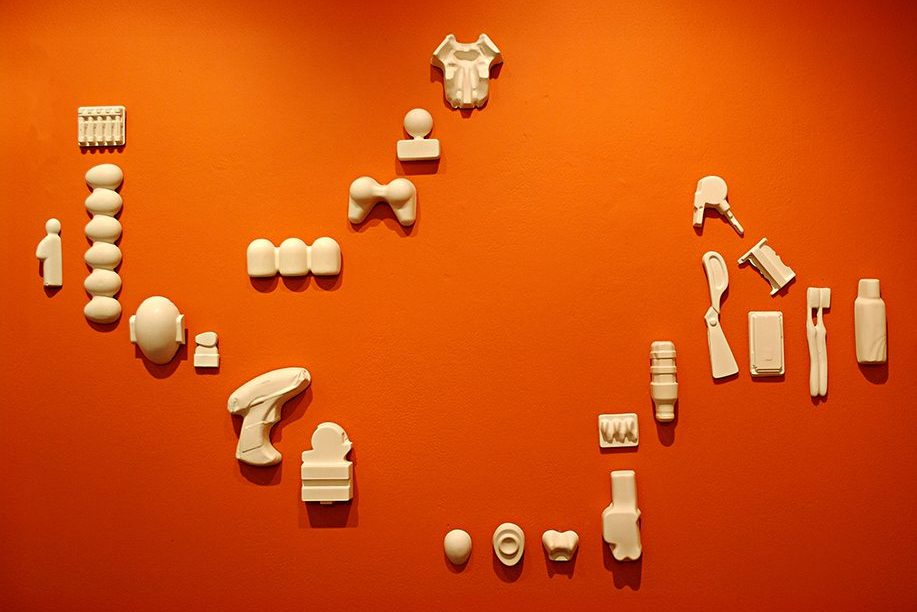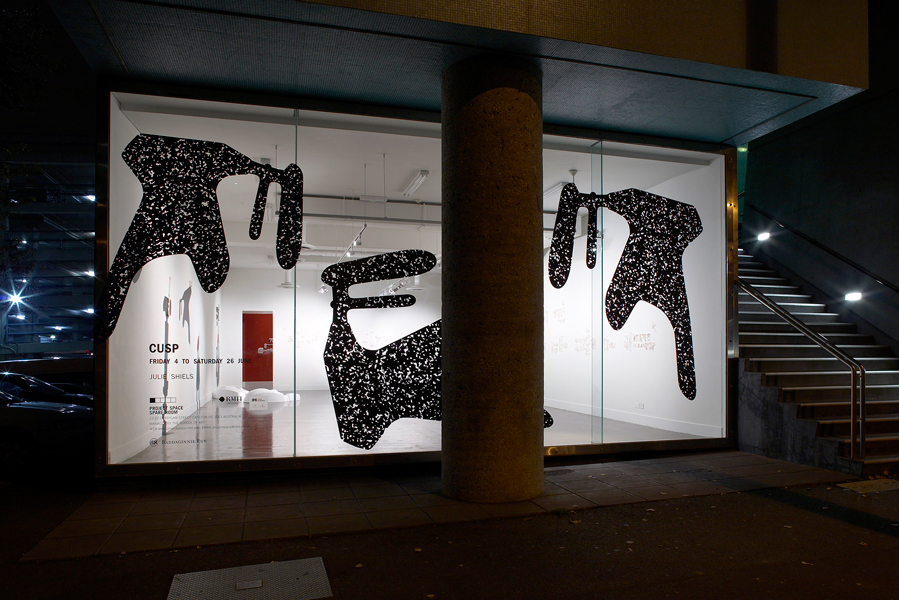

UBIQUITOUS OBJECT, AMBIVALENT THINGS: PhD Exhibition, Margaret Lawrence Gallery, 2015
The ambivalent things in this exhibition emerge from ubiquitous objects: clear plastic packages or blister packs. Rather than working with trash as constituent materials, this project focuses on the space left behind by the act of consumption, abstracting and reproducing the void in discarded packaging.
Ubiquitous Object, Ambivalent Things reflects on the how remnants of consumption might be apprehended beyond the status of the commodity and endeavours to navigate around ‘aesthetic fatigue’ — a visual overload of images relating to waste (Scanlan 2013). The project uses the ‘ready made’ mould of the plastic package to visualise the space of consumption, inviting poetic reflections on the temporality, materiality and mutability of waste.
PhD Extended Abstract: Ubiquitous Object, Invisible Things:
Material Affect, Objects 1 – 9 (2013) photogram — silver gelatin print, 93 X 111 cm.
Shrink (2015) vacuum formed acrylic and vinyl lettering (Lorem Ipsum), various dimensions.
Things Fall Apart (2013 – 15) peg board and dry plaster, 232 x 360 cm.
Breach (2015) plaster and MDF, 240 x 250 cm.
Hook (2015) resin, various dimensions.
Gap (2012) acrylic dye and thread, 400 x 250 cm.
Resisting Disappearance, Texts 1 – 4 (2015) digital print, various dimensions.
Resisting Disappearance is derived from the empty space found in clear plastic packaging. The transparent form of the empty vacuum package is both an object in itself and an echo of the commodity it once encased.
The voids in these ready-made moulds have been amplified and transposed using two ephemeral materials: light and dried plaster. Julie Shiels uses a combination of photograms and loose caste objects to visualize a trash item in a way that can be perceived beyond its status as commodity. The project seeks to reflect on the temporality, the materiality and the mutability of waste.
Loose plaster, MDF, digital prints. Dimensions variable.
Twenty-five kilograms of dry plaster powder is given form when it is packed into the empty space in a clear plastic package that once held a consumer item.
Things Fall Apart combines two machine-made spaces that are used to order and protect everyday objects. The first is the empty space in a clear plastic package that once contained a consumer item. The second type of space is the hole in a handyman’s peg-board. These spaces are reassigned in a way that extends both their original purpose and their materiality.
The package is used as a mould to distribute serial forms across an expansive platform made from a handyman’s pegboard. The mould and the material are the same in each case, yet no one form is identical to another.
During this exhibition the same sack of plaster will be transformed three times. Each week the powdery castes will be swept up and reformed into a new set of relationships and patterns. However despite these efforts by the artist to influence the relationship between objects, the crumbling forms will assert their own agency and affect each other ‘even when humans are not watching’.[1]
Combining the regular pattern of holes with repetitions of the powder casts This is an experiment with certainty and instability, order and unpredictability, of control and letting go and challenges our anthropocentric version of the world.
[1] Graham Harman “Autonomous objects” New Formations No. 71, pp. 125-130 (2011)
Catalogue Essay
Things e-catalogue (PDF) →
The psychology of consumption is dominated by repeated attempts to create internal meaning, satisfaction and a sense of self through the acquisition of external things.This series of works reproduces the empty spaces left when domestic consumables are removed from their plastic packages to explore the experience of consumption and reflect upon the emotions it evokes. Unlike most artworks using ‘readymades’, this work is derived from discarded space rather than discarded objects. It takes advantage of the already abstracted form of the package that once held a recognisable household item.
This exhibition presents different iterations of this ‘readymade’ space using a range of materials including loose plaster, aluminium and light – used as a ‘material’ to create photographic imprints or photograms.
Objects 1 – 10 Silver gelatin prints on fibre-based paper 120 x 100 cms
Photography: Christian Capurro and Julie Shiels
When a person undergoes a surgical procedure the operation is booked, the risks are assessed and the date anticipated. On the day, the body is prepped and dressed in a special gown but as consciousness slips away, the actual event becomes a void.
Cusp, materialises this void by casting the space in empty packaging that once held surgical implements and devices used in the operating theatre and asks: can these memories be reclaimed? Can we insert our own narratives of illness, healing and intervention into these empty spaces or would we prefer to forget. What and where is this space we inhabit?
Project Space: RMIT, 2010
They flock together – patterns across the wall: a collection of objects cast from the empty spaces left behind in plastic packaging. Sourced from the tool box, the toy box and the domestic environment, the original moulds are the wallpaper of our daily lives – ever present but barely noticed.
23 July – 2 August 2008
Opened by Julian Birnside
Flock: Catalogue essay by Marian Crawford